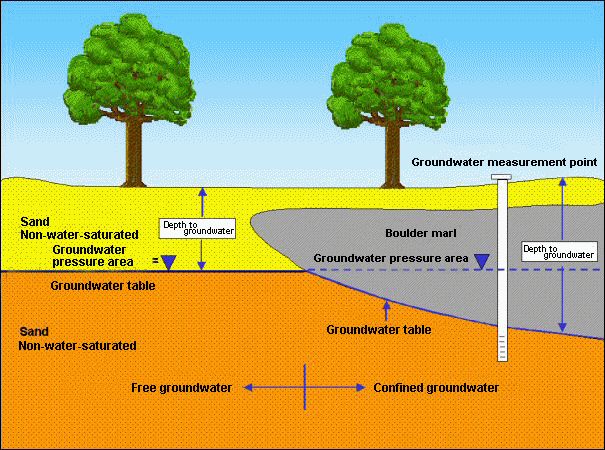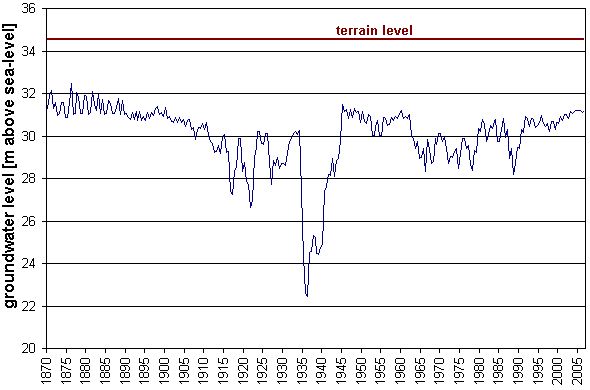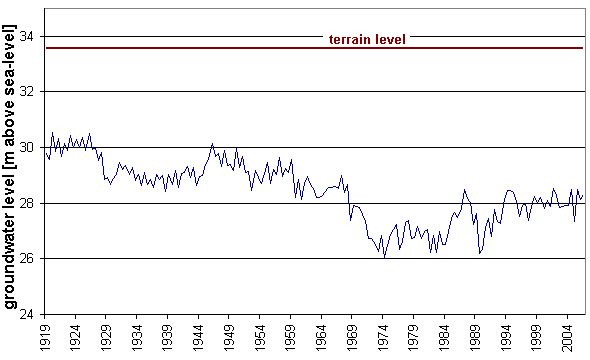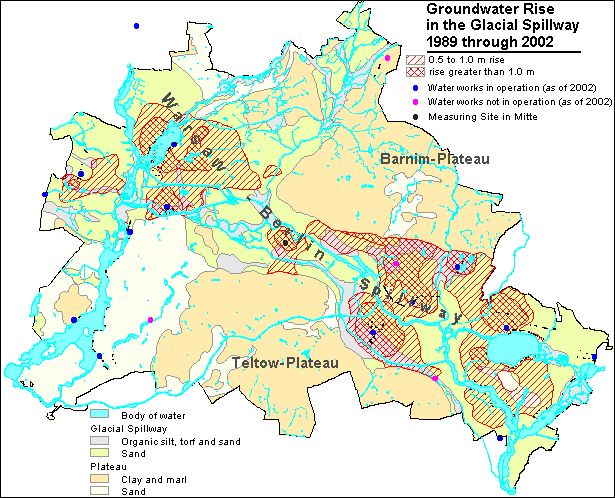The depth to the water table is defined as the perpendicular distance between the upper edge of the surface and the upper edge of the groundwater surface. If the groundwater aquifer is covered by relatively impermeable, cohesive layers (such aquitards as boulder marl), so that it is unable to rise to the level that its hydrostatic pressure would dictate, it is considered to be confined groundwater. In such a case, the depth to the water table is defined as the perpendicular distance between the upper edge of the surface and the lower edge of the groundwater-obstructing boulder-marl layer which covers the aquifer (cf. Fig. 1).
The Map of Depth to the Water Table gives an overview of the spatial distribution of areas with the same depth classifications, at a scale of 1 : 50,000 (SenStadt 2006). It was calculated on the basis of the data of May 2006, and applies to the respective near-surface aquifer with an uninterrupted water supply. In Berlin, this in most cases means the main aquifer, which is used for water supply (Aquifer 2, according to the structure of Limberg und Thierbach 2002), and which is unconfined in the glacial spillway, but confined in the more elevated areas. In exceptional cases, the Aquifer 1 (e.g. in the area of the Panke Valley) or the Aquifer 4 (tertiary formations) were used to determine the depth to the water table.
Areas with a lesser depth to the groundwater table (to about 4 meters) are of particular importance. Soil pollution can quickly lead to deterioration of groundwater in these areas, depending on the nature of the mantle (permeable or non-permeable) above the groundwater. The Map of Depth to the Water Table is thus a significant basis for the preparation of the Map of the Protective Function of Groundwater Coverage (cf. Map 02.16). The spatial overlaying of depth to the water table onto geological characteristics of the covering mantle permits the delimitation of areas of varying protective functions of groundwater confinement).
Knowledge of depths to groundwater moreover permits an assessment of the effect of groundwater on vegetation. This depends on the root depths of plants and, depending on soil type, of the capillary climbing capacity of groundwater. The threshold depth at which groundwater can be used by trees under the conditions prevailing in Berlin is generally given as 4 meters. Vegetation in wetlands depends mostly on the groundwater, and requires a depth to the water table of less than 50 cm.
Fluctuation of Groundwater Levels
The groundwater level in the city is subject to various anthropogenic influences. The first lowering of the groundwater level and the destruction of wetlands in the Berlin area was caused by the drainage of such swampy areas as the Hopfenbruch in Wilmersdorf in the 18th century. The 19th and 20th centuries saw the drainage of other areas due to the construction of canals. The groundwater level was further lowered by the increasing demand for drinking and process water, and by restrictions on groundwater recharging caused by surface sealing, or was subjected to strong periodic fluctuations, with amplitudes of up to 10 meters at a site.
Up to the end of the 19th century, the mean groundwater level in Berlin was subject only to the annual fluctuation in precipitation. During the period between 1890 and the end of World War II, the rising water demands of the rapidly growing city, as well as unwatering operations, marked the water-supply picture. Large-scale unwatering of the subway and urban-rail networks (Alexanderplatz), and other major construction projects caused the groundwater level in the inner city to drop dramatically by up to 8 meters. With the breakdown of the public water supply at the end of the war, the depth to the water table was able to recover almost to its natural level (Fig. 2).
During the ensuing period, from the early ‘50s to the early ‘80s, the groundwater level sank continually and over large areas because of increased withdrawal. This was particularly noticeable in water discharge areas (waterworks facilities). The lowering was caused by the general rise in water consumption by private households, and by construction (rebuilding of the severely destroyed city, subway construction, and large-scale construction projects). The expansion of water discharge facilities in the West Berlin waterworks was completed by the beginning of the ‘70s. The expansion of the Friedrichshagen Waterworks in East Berlin began in the mid-‘70s, to supply water to the new residential areas in Hellersdorf, Marzahn and Hohenschönhausen.




